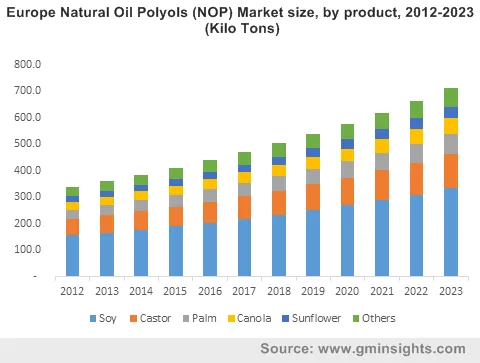Home > Chemicals & Materials > Specialty Chemicals > Custom Synthesis > Natural Oil Polyols (NOP) Market
Natural Oil Polyols Market Size
Natural Oil Polyols (NOP) Market size was over 18 million tons in 2015 and is forecast to grow at more than 7% CAGR up to 2023.

Biobased polyurethane (PU) demand was over 1600 tons in 2015 and projected to surpass 2600 tons by 2023, growing with estimated gains of 6.5% CAGR up to 2023. Increasing bio polymers application scope in various end use industries owing to its sustainable properties are key trending factors to drive global natural oil polyols market growth.
Major conventional PU manufacturers are preferring to shift towards utilizing eco-friendly products derived from biomass for product manufacturing. A number of biotechnology companieshave been collaborating with leading playes for technical know how for manufacturing bio based PU. Biomass based raw materials will help to curb carbon emissions and are expected to be economically sustainable which may positively influence durability & performance of PU.
Industry shift towards development of bio-based products in order to reduce dependency on petrochemicals may drive NOP market size. They are comparable in terms of longevity and sustainability when used as a substitute for petrochemical polyols. Polyurethane is expected to be sustainable and may positively impact performance and durability.
| Report Attributes | Details |
|---|---|
| Base Year: | 2015 |
| Forecast Period: | 2016 to 2023 |
| Historical Data for: | 2012 to 2015 |
| No. of Pages: | 76 |
| Tables, Charts & Figures: | 54 |
| Segments covered: | Product and Region |
Increasing application scope in automotive, construction and furniture industry to reduce conventional plastic usage are considered to favor NOP market size growth. Favorable government initiatives in order to reduce green house gases (GHG) emissionsmay positively infuece the demand. EPA and REACH compliances to promote environment friendly products pertaining to health and ecosystem safety are key promising factor to stimulate natural oil polyol demand.
Furthermore, the European Emission Standards (EES) is increasingly implying stringent regulations on vehicular emissions from tail pipe. The trend of continuous efforts to reduce vehicular emissions is anticipated to continue over the next few years. These emissions are highly influenced by the overall vehicle weight, which may be lowered by using bio-based materials to build the chassis of the vehicle.
Japanese Government’s Biomass Nippon Strategy post-adoption of the Kyoto Protocol has prompted companies such as Toyota and NEC to accelerate their R&D levels into bio-based plastics and to raise the bio-based content of their products. Toyota is planning to switch 20% of the plastics used in its vehicles to bio-sourced plastics by 2015 and expects bioplastics to help in its efforts to accomplish its company-wide goal of reductions in CO2 emissions. Diversification and growth of niche application segments such as food and cosmetics industry may fuel industry growth. Additionally, companies such as Vertellus and BioAmber have been investigating commercial viability of 100% bio-based polyols. Increasing R&D spending coupled with introduction of 100% bio-based NOP may provide lucrative opportunities to industry paticipants in near future.
Key raw materials, castor, soy, rapeseed, tall, cotton and sunflower oilseeds, are majorly used for NOP production. Rapeseed oil supply is challenged owing to growing demand from food and animal feed applications.Increasing scope of key raw materials for biofuels and industrial applications may create supply demand gapand impact the natural oil polyol market price trend.
Natural Oil Polyols Market Analysis
Soy oil polyols market dominated the product landscape and was valued over USD 1.7 billion in 2015. Raw materials availability owing to increasing soy acreages mainly in U.S. and Brazil is estimated to drive NOP market size.
Increasing soy oil demand in other alternative industrial applications such as fuel additive and other polymers may be attributed for low availability. Increasing penetration of PU demand in furniture, automotive and construction industries may have positive influence on the market growth. Castor oil products set to witness highest gains, growing at over 7.5% CAGR up to 2023. High purity and resistance towards hydrolysis are key stimulating properties to drive product demand. Castor oil polyol is one of the purest commercially available productrequiring minimalistic modifications as compared to other counterparts such as soy oil and palm oil.
Palm oil derived product are estimated to register significant growth of over 7% during the forecast period. Advancements in extraction techniques coupled with increasing acreages of castor and palm particularly in south east asia is estimated to have a positive impact on the supply of natural oils over the forecast period.
North America NOP market size dominated the regional industry and was valued at over USD 2.1 billion in 2015. U.S. and Canada are key contributing countries owing to favorable government regulations and consumer awareness.
APAC, predominant by India & China natural oil polyols (NOP) market size, is forecast to attain highest gains at 7.5% CAGR up to 2023. Raw material availability accompanied by presence of large scale manufacturing industries are key factors fostering regional growth.
Latin Ameirca, led by Brazil, may witness gains at over 9.5% and surpass USD 400 million by 2023. Construction industry growth coupled with increase in automobile sale may drive Latin America market growth.
Natural Oil Polyols Market Share
Global natural oil polyols market share is fairly consolidated and technology driven. Major industry players include
- Cargill
- BASF
- Dow Chemical
- Hunstman
Other industry participants include
- BioBased Technologies LLC
- Stepan Company
- Jayant Agro Organics
- Elevance Renewable Sciences
- IFS Chemicals Group
- EmergyOleochemicals
- Mitsui Chemicals
- Lubrizol
- Vertellus Specialties
- Bio Amber
- Urethane Soy Systems
- Covestro (Bayer Material Science)